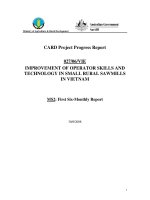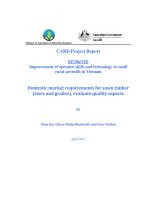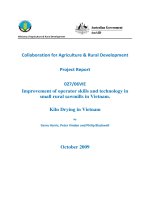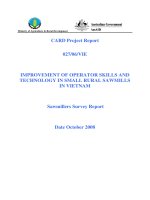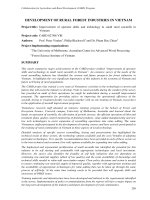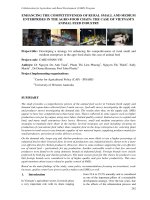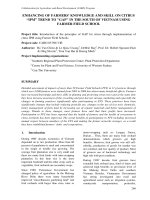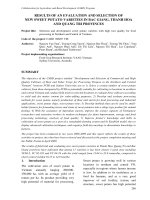Báo cáo nghiên cứu nông nghiệp " Improvement of operator skills and technology in small rural sawmills in Vietnam " potx
Bạn đang xem bản rút gọn của tài liệu. Xem và tải ngay bản đầy đủ của tài liệu tại đây (13.38 MB, 12 trang )
Collabor
ation for Agriculture and Rural Development
(CARD)
Program
250
DEVELOPMENT OF RURAL FOREST INDUSTRIES IN VIETNAM
Project
title:
Improvement of operator skills and technology in small rural sawmill
s in
Vietnam
Project c
ode
:
CARD 027/06 VIE
Author
s:
Prof.
Peter V
inden
1
, Philip Blackwell
1
and Dr. Pham
Duc Chien
2
Project Implementing organi
s
ations:
1
The University of Melbourne, Australian Centre for Advanced Wood Processing
2
Forest Science Institu
te of Vietnam
SUMMARY
This report summaries major achievements of the CARD project entitled “Improvement of operator
skills and technology in small rural sawmills in Vietnam”. An extensive survey of the needs of the
rural sawmilling industry has identified
the current and future prospects for forest industries in
Vietnam. It highlights the very significant importance of this industry to the economy of Vietnam and
future well being of rural populations.
The CARD project has trained a core team of Vietnames
e scientists in the technologies (current and
future) that will assist the industry to develop. Visits to rural sawmills during the conduct of the survey
has provided an audit of their operations (as might be undertaken during a sawmill improvement
program
). The opportunity for providing advice on improving the operational efficiency of the
sawmill, drying or treatment facility was taken together with on
-
site training of Vietnam researchers
in the application of sawmill improvement programs.
Vietnamese res
earch staff attended an intensive training program at the School of Forest and
Ecosystem Science, Creswick campus, University of Melbourne, Australia and learned about the
hands on operation of sawmills, the alleviation of growth stresses; the efficient op
eration of kilns and
treatment plant, quality control monitoring of finished products, value added manufacturing and new
low tech technologies to assist expansion of sawmilling operations into value adding. The same
Vietnamese staffs participated in the de
velopment of training courses and have actively participated in
the training of rural communities in Vietnam in these aspects of wood technology.
Detailed analysis of specific sectors (sawmilling, drying and preservation) has highlighted the
technical need
s of these sectors, the technology options available and the cost / benefits of adopting
particular technologies. Very specific recommendations have been provided in each of these sectors as
to the best technical and economic (low risk) options available f
or expanding into value adding.
The haphazard and exponential proliferation of small sawmills has identified the potential for this
industry to be self starting and sustainable with appropriate technologies and local investment.
However, the survey also i
dentifies the fragility of self help initiatives that are dependent on
continuing raw material supplies (albeit of low quality) and the scant availability of knowledge and
technical skills needed to value
-
add sawn timber output. Clear policy decisions and
action is needed
to ensure continuing raw material supply of improved quality, together with appropriate training and
the availability of appropriate technologies for value adding that can be taken up through the same
process of self
-
help. At the same time
training needs to be provided that will upgrade skills and
awareness of OH&S issues.
Training materials and infrastructure have been developed and tailored to the requirements identified
in the survey. Implementation of policy recommendations from the re
ports will have a major impact on
the long
-
term development of the industry and future development of rural communities.
CARD 027/06
–
Improvement of rural sawmills
251
The most significant outcome of the project is that rural communities have articulated their perception
of the future needs of their se
ctor, their aspirations and fears for the future as well as their vision of
what potentially could develop in terms of expanding their activity. To a greater extent the sawmilling
community has articulated optimism in the light of opportunities that are av
ailable in developing
products and markets.
The project has provided the Vietnam Forest Service with a blue print or plan that is relatively low
risk in its implementation, but which recognises what has been achieved by the rural community in
low tech proc
essing of plantation logs and builds on this through a “New Forests” strategy and
Government investment in an innovative program of research, training education and out
-
reach.
1.
Introduction
An overview of Vietnam’s forest industries
and domestic market
(Chien et al 2010).
Identifies the following salient points:
Sawn timber production in Vietnam
exceeds 2 million m3 /annum.
Wood exports rank fifth in importance
behind crude oil, textiles, footwear and
seafood
Exports increased on average by 43%
annually
between 2000 and 2008.
Vietnam has become the 4th largest global
manufacturer and exporter of furniture that
together with handicrafts are exported to
over 100 countries.
Domestic production of timber is
supplemented by significant imports of
unprocessed
logs. Fifty
-
three percent of
logs processed in Vietnam are imported.
The value of timber imports exceeds US$1
billion.
Vietnam uses 11 million m3 of wood / year
of which 57% is used for sawn timber for
producing outdoor and indoor furniture and
constructio
n timber. The percentage end
-
use of acacia produced by rural sawmills
(derived from questionnaires directed at
small rural sawmills, (Blackwell et al,
2009) highlights also the importance of the
domestic markets for furniture production.
Domestic productio
n of raw logs from
plantations is expected to grow
substantially following the Vietnamese
Governments objectives (1998) of
establishing a 5 million hectare
reforestation program. Various estimates
(e.g. MARD, 2010) estimate that by 2020,
Vietnam could be c
apable of supplying 20
million m3 annually. Currently domestic
wood production from plantations is
expanding at about 10% / annum. This has
offset a reduction in the availability of
wood from natural forests.
Seventy
-
five percent of the current harvest
fro
m plantations comprises acacia spp. This
percentage is expected to increase.
The plantation rotation age for acacia is
approximately 7
-
8 years. Logs have a small
average diameter of approximately 250
mm.
Very little information is available on the rural
sa
wmilling industry in Vietnam or its
prospects. The objectives of this project were
therefore to:
Identify and define industry problems,
needs and opportunities through a
comprehensive survey and review of the
rural sawmilling industry.
Establish processes
and infrastructure for
training and technology development
Develop and conduct training programs to
improve operator sawmilling and business
skills for trainers and for mill operators.
Investigate demonstrate and recommend
more appropriate or alternative
t
echnologies to improve industry
performance.
Develop long
-
term strategies for industry
development
2.
Materials and methods
An inception meeting of stakeholders from
industry, education and research institutes,
government, bilateral and multilateral aid
a
gencies was held to identify industry
problems, needs and opportunities. Detailed
questionnaires were developed with input from
the inception committee. Vietnamese project
participants attended a training program in
Australia to develop and refine survey
m
ethodology and review appropriate wood
processing technologies. The industry survey
Peter Vinden, Philip Blackwell
&
Pham Duc Chien
252
and review was undertaken by a joint
Vietnamese / Australian team in representative
provinces, in cooperation with provincial
Departments of Agriculture and Rural
Developme
nt.
The survey was conducted in the form of a
participatory rural appraisal (PRA). Individual
mills were visited and the following types of
information sought from owners: log volume
input, sawn wood output and grades, price and
cost data, end
-
use markets
, equipment used,
employee statistics, problems identified by
owners, and owner’s views on development
needs of industry. A complementary survey
was also undertaken to include plantation
growers to assess their views on markets and
prices and sawn timber b
uyers to assess their
views on sawn wood products purchased. The
findings were supplemented by a separate
report outlining the current state of
development of forestry and the forest
industries in Vietnam, their contribution to the
economy and rural develo
pment and potential
to grow in the future. These reports were used
as background to developing more detailed
reports on individual sectors of the industry
including sawmilling, wood drying,
preservation, forest industries education and
training, research a
nd extension.
Structured programs of sawmill training for
rural communities were developed based on
the needs analysis identified in the survey of
rural sawmills. The focus for this training was
technical rather than training in business skills,
since it
was anticipated that this was the area
of greatest need. Course materials in the form
of Technical Notes and overheads were
developed for these courses. A “train the
trainer” course was held in Australia for
Vietnamese participants and again in Vietnam.
Fo
ur sessions of rural training were completed
successfully by the CARD project and feed
-
back obtained from course participants.
3.
Research results and discussions
Survey results from the small rural sawmilling
industry highlighted a chronic problem for
mo
st rural sawmills in ensuring an adequate
and consistent supply of logs for their
businesses. To a greater extent the use of
small
-
scale low capacity horizontal bandsaws
can be viewed as “opportunistic processing of
raw materials as and when the opportunit
y
arises”. The current focus of raw material
(acacia) producers is to produce wood chips
for export. Wood chips represent a low value
product and there is enormous opportunity loss
in satisfying local demand for furniture and
potential markets in building
and construction
that have not been realised. The absence of any
planned long term supply of logs to rural
sawmills servicing the domestic market means
that there is insufficient security for any
entrepreneurial activity to either invest in kiln
drying equ
ipment or sawmilling equipment.
The problem is difficult in Vietnam because of
a shortage of suitable forestry land, the small
size of farms where farm forestry might be
practiced.
Analysis of the forests industry sector
highlights a number of important a
ttributes
impacting on future directions for the industry.
Firstly the forest products industry is an
important export
-
earning sector that should
continue to expand in the future. Protocols
need to be in place to ensure that pests and
diseases are containe
d and are not imported
with unprocessed logs. Control methods need
to be in place pending outbreaks of timber and
forest diseases. Export of furniture and crafts
requires similar safeguards i.e. inspection to
ensure that exports are free of any pests that
may lead to barriers being imposed because of
potential infection risks in the importing
country. There is increasing international
awareness of the importance of containing and
minimizing risks of disease transfer between
and within national boundaries. D
omestic
production of timber destined for high value
uses such as furniture manufacture or export
needs to be free from sap
-
stain that may arise
during log handling and transport. There is an
unrealized market potential for domestic
timber production to be
used in construction.
Realisation of this potential demand needs to
be preceded with the implementation of some
preservative protection against termites and
decay that will be required for sapwood
protection.
CARD 027/06
–
Improvement of rural sawmills
253
Results of an intensive survey undertaken of
t
he rural saw
-
milling industry engaged in the
processing of acacia and eucalyptus species
Vietnam identified that approximately 90 % of
the rural sawmills operating in Vietnam are
family businesses. Ten percent are private
companies. The growth in rural saw
mills has
been relatively recent. Of all the sawmills
interviewed none had been in operation longer
than 18 years. The average time that sawmills
had been in operation was 5.3 years thus
indicating that the expansion of the rural saw
-
milling industry has b
een very recent. This
probably reflects the maturing of acacia
plantations that forms the raw material base for
this industry and the freeing up of the economy
to promote entrepreneurial activity. The survey
identified that a large number of the rural mill
s
only operated part time.
Table 1.
Percentage number of sawmills
operating full time
Region
Full time operation
North
25
Central
52
South
47
However, of those mills that indicated that
they were operating full time a large number
identified reas
ons as to why there were
substantial periods of down time. Key issues
comprised:
Lack of a c
ontinuity in the supply of logs;
Inconsistent markets.
Other reasons identified included:
That they only supplied local needs that were
seasonal or
That they s
upplied specialised end uses such as
coffins, joinery etc.
Bad weather and
Inconsistent power supply.
Despite a potential over capacity for sawing
the available raw material and inadequate
markets, 44% of sawmills indicated either
plans to expand or a wi
sh to expand their
activities. Target expansion areas were
primarily furniture manufacturing (78% of
respondents) of whom 21% indicated that they
would like to focus on high value export
markets. Other markets included handicrafts,
and kiln drying of timbe
r. Reasons forwarded
for identifying these potential opportunities
related to a perception that there were
substantial market opportunities in these
particular sectors. The main obstacles
hindering expansion related primarily to a lack
of funding followed
by the lack of available
skills. Other issues included the availability of
quality raw material, lack of good managerial
skills, a lack of knowledge and unstable
market conditions. In most instances, there was
a perception that there was an expanding
marke
t for furniture and that expansion into
such areas would stabilise demand for sawn
timber.
Fig 1
.
Typical verticcal sawmill with carnage that
moves the logs past the saw
Fig 2
.
Typical horizontal sawmill with operators
pushing the saw over the log
Saw
-
milling equipment (horizontal and
vertical bandsaws) have been manufactured
almost exclusively in Vietnam. Mill expansion
usually involved purchasing addition mills.
Most sawmills also owned circular saws.
These have been introduced more recently for
recutting flitches into sawn timber for furniture
and other end uses. Virtually all mills had
rudimentary saw doctoring capability. The
equipment was purchased new. However,
skills in saw doctoring varied enormously
between mills. None of the mills survey
ed
indicated any modifications to purchased
equipment indicating that in general the saw
-
milling equipment was suitable for the sawing
Peter Vinden, Philip Blackwell
&
Pham Duc Chien
254
of acacias. Only 12% of mills surveyed had
plans to upgrade equipment. Emphasis on
replacement focused on:
Purchasing ver
tical bandsaws because
these were more suitable for sawing
small logs,
Establishing furniture manufacturing
equipment,
Replacing old circular saws.
Further processing undertaken by
sawmills to add value include:
Air
-
drying. Only a third of all sawmills
eng
age in drying.
Kiln drying is undertaken by relatively
few mills, although a number of mills
send their timber to enterprises that
specialise in kiln drying,
Preservative treatment was being
conducted by 13 enterprises
Integration of sawmills into
manufact
uring was reported and focused
mainly on furniture pallet making and
construction.
Those companies involved in kiln drying were
experiencing very serious problems
particularly in relation to drying to a consistent
moisture content and identifying suitable
drying schedules for eucalypts and some native
species. The Australian team observed some
larger enterprises (not covered by the terms of
this survey) that had invested heavily in kiln
drying equipment. These kiln were not
operated correctly and results
for the more
difficult to dry species were unsatisfactory, the
main cause was lack of training of the
operators and limited understanding of the
principles of timber drying. Discussions with
the kiln operators revealed a genuine interest in
learning and
getting an understanding of how
they could improve the quality of the finished
products.
Log storage times at the sawmill were on
average 1 month in the South 1.1months in
Central Vietnam and 0.6 months in the North.
The total elapsed time from tree fellin
g and
transport to the log storage yards was not
identified. However, storage in extreme cases
at the log yard was reported to be as long as 6
months. Strategies need to be implemented to
streamline the logistics of supply to reduce log
storage time partic
ularly given the incidence of
decay that was reported by 29% of
respondents. Log supply was identified as a
problem for 57% of respondents, mainly
because of “availability”. The wet season also
compounded the problem often resulting in a
discontinuity in s
upply. Research needs to
address the whole question of log supply.
Techniques need to be developed to reduce
sap
-
stain including proper housekeeping
techniques at the sawmill to lift logs off the
ground and provide timely rotation of the
stockpile. This i
s needed to avoid the
development of a decay environment in the
yard. The biggest problem (25% of
respondents) in relation to log quality was the
presence of sweep (i.e. bent logs). Inevitably
sweep resulted in the crosscutting of logs into
short lengths.
The most common log length
was 2.4 metres.
An end use analysis of timber derived from the
survey is summarised in table 2.
CARD 027/06
–
Improvement of rural sawmills
255
Fig
3
.
Two methods of air drying typical for sawmills in Vietnam
Table 2.
End uses of acacia sawn timber in V
ietnam by region
End use
Total Vietnam
North
Central
South
Furniture
42%
57%
48%
27%
Construction
26%
34%
28%
21%
Flooring
2%
2%
5%
0
Pallets / Crates
24%
2%
19%
42%
Unknown
1%
1%
1%
0
Other
5%
5%
0
10%
TOTAL
100%
100%
100%
100%
Fig
4
:
I
nside a kiln
Fig
5
:
Pressure treatment vessel in large sawmill
These statistics highlight a very high
proportion of timber being used in furniture
manufacture, particularly in North and Central
Vietnam. In the South, pallets and crates
domi
nated the market. In construction, timber
is used mostly for formwork (shuttering for
concrete). This is a relatively low value (but
important) end use and the life cycle for the
product is relatively short. Pallets and crates
representing 51% of the marke
t in South
Vietnam comprise low value markets. Timber
is usually rough sawn with no value adding in
terms of drying or machining. Quality
requirements for this market are also relatively
low. Once again the life cycle is relatively
short. Furniture and flo
oring represent high
value markets. Expansion in these markets is
hampered by an apparent shortage of suitable
Peter Vinden, Philip Blackwell
&
Pham Duc Chien
256
logs. Limitations in the availability of longer
logs, which is also frustrated by the logistics of
transport and man handling will also limit
ma
rket development in construction. There is
an expectation that the domestic furniture
market will continue to develop as marketing
and distribution become more sophisticated
and better quality logs become available.
All respondents to the survey completed
a swot
analysis (strengths weaknesses, opportunities
and threats). To a greater extent many of the
strengths were also identified as weaknesses
Strengths
Cheap labour
Experience
Easy to run business
Cheap equipment
Weaknesses
Technology and equipment is
old
Lack of knowledge in marketing,
business and management skills
Lack of finance
Unstable market demand
Space for expansion is limited
Opportunities
Expanding into furniture manufacture
Government policy that allows
a
sawmill to run its own business
Inc
reasing plantations
Increasing demand for products
Open markets.
Threats
Competition
Unstable markets
Policy change
Unstable log supplies
Safety,
Unstable log supply,
Simplicity of products
Lack of skilled workers,
Small size of business
Limited inves
tment funds
A summary of industry attitudes towards
current training in wood processing is
summarised below. Data has been
amalgamated for all regions (i.e., North,
Central and South).
Table 3.
Survey analysis of past training
experience by sawmills
(Un
it
%
)
Staff receiving training in the past
13
Enterprises interested in receiving
training
73
Enterprises indicating that the
quality of existing training courses
was a problem
53
Enterprises indicating that the
training in the past wasn’t relevant
to
their needs
63
The survey analysis of past training experience
in forest industries in Vietnam (Blackwell et al
2010) poses a serious problem, firstly because
of the low incidence of staff and labour
working in sawmills receiving any training,
secondly be
cause literacy levels in this
industry are very low, thirdly because of the
number of sawmills indicating that the quality
of training was a problem and fourthly because
of the number of enterprises that felt that the
training available wasn’t relevant to
their
needs. On the positive side, 73% of enterprises
indicated interest in receiving training. The
low quality of training and the relevance of the
training that is provided rank very high in
terms the problems identified by the industry
and probably acco
unts for the low uptake of
training that is provided. The loss of labour
arising from staff attending training courses is
also a significant factor indicating that training
provision should be mobile and centre around
clusters of mills.
Table 4.
Survey an
alysis of training problems
Training Problems
Ranking
Low quality of training.
73
Fees are too high.
0
Loss of labour.
40
The training is not relevant.
63
Training is not suited to the equipment.
20
The distance is
too far for training.
13
The equipment at the institute is too old.
3
The same questionnaire attempted to prioritise
the topics that enterprises felt were important.
CARD 027/06
–
Improvement of rural sawmills
257
The topics have been ranked based on the
priority accorded by those enterprise
s
interested
in receiving training (table 4
).
Table 5.
Ranking of training topics
Topic
Ranking
Further manufacturing
13.4
Saw Sharpening
12.2
Sawmill Practices
11.8
Marketing
11.5
Business management
9.1
Air Drying.
9.1
Pr
eservation
8.7
Equipment
8.7
Kiln drying
7.5
Wood properties.
4.7
Sawmill safety
4.0
Saw maps
3.2
Sawmill owners clearly identify further
manufacturing as the highest priority, followed
closely by saw sharpening, sawmill pract
ices
and marketing. We believe that this highlights
concerns on the part of sawmill owners who
are focussing on how they can add value to
their current sawmill businesses, through better
hands
-
on skills; how marketing can improve
their sales performance an
d how their day to
-
day performance can be lifted through
improved saw sharpening and better sawmill
practices.
A second tier of skills focuses on business
management, drying (air drying followed by
kiln drying), preservation and equipment
handling.
Element
s of enterprise management that need
further development include:
Information Technology and
Communication.
Project Management.
Leadership and Working in Teams.
Service Quality.
Occupational Health & Safety.
Managing Staff
Financial Management for
Resource
Ind.
Forest Products Marketing
There are natural groupings for subjects to
provide intermediate qualifications. Ideally a
National Certificate, National Diploma and
National Advanced Diploma leading to
articulation into undergraduate qualifications.
4.
Conclusions
The survey provides a snap
-
shop of a rural
industry that has expanded very rapidly in the
last decade following the maturing of acacia
and eucalypt plantations. There are similarities
in the responses to the survey conducted in
North, Central a
nd South Vietnam. The
expansion has arisen as a result of government
policy that has encouraged entrepreneurship
and market freedom, a cheap labour force,
cheap raw materials (logs), cheap robust saw
-
milling equipment that has coped with the
relatively sma
ll diameter logs and a
Vietnamese work ethic that has succeeded in
building an important rural industry that has
flow on benefits to the local community.
The first question that arises is whether the
“old fashioned” saw
-
milling equipment has
served its pur
pose and whether more
sophisticated saw
-
milling equipment should be
encouraged. In the short and medium term the
answer to this is probably no. Sawmill
efficiency (conversion of logs into sawn
timber) is amazingly high given the quality of
logs that are av
ailable to most of the rural
sawmills. It is unlikely that an improvement in
yield could be achieved by introducing more
sophisticated equipment. A very high
proportion of sawmills are not operating to full
capacity. Equipment breakdown was not
identified
as a core reason for equipment
working below capacity; rather raw materials
supplies and inconsistent markets were
identified as primary reasons. Higher cost
more sophisticated sawmills would exacerbate
this problem. The capital cost for establishing
a hor
izontal Vietnamese sawmill is very low,
US$3
-
4,000. The fact that the sawmill is not
operating to capacity is unimportant in terms
of paying off capital, whereas the introduction
of more sophisticated in
-
feed and out
-
feed
systems and automation would see m
ore than a
hundred fold increase in the capital investment
needed. This changes the nature of the
Peter Vinden, Philip Blackwell
&
Pham Duc Chien
258
business from being low cost, rural, part time,
seasonal and flexible to being full time, ideally
3
-
shift, inflexible, labour reducing industrial
production.
Transportation costs for logs to
larger fewer mills would increase. Many of the
locations currently used by small horizontal
sawmills would be totally unsuitable for
expansion into larger mills since many are on
sites that can’t expand or are located adjac
ent
to dwellings.
Potentially there is no value to be achieved
from the government providing financial
incentives for establishing more low cost
sawmills. The investment needed to establish
new mills is low and is best left to market
forces. However, at th
e same time as the
survey was conducted audits were undertaken
of kiln drying operations. Many of the kilns
inspected were imported and of high quality.
In addition Vietnamese manufactured kilns
ranged from being well
-
designed units that met
the requiremen
ts for drying acacia and
eucalypt species, through to poor quality in
-
house built units, which produced questionable
quality material. However, operation of all of
these kilns was sub
-
optimal due to the failure
to use fairly basic drying principles and
uti
lisation of standard monitoring equipment
(i.e. wet bulb sensors) to ensure correct
operation. In other words drying was achieved
using an oven or ‘hot box’ rather than a
properly controlled dry kiln. The inevitable
consequences of this resulted in drying
degrade, non
-
uniform moisture content and / or
over drying. This is a training issue since most
of the kilns audited had the equipment
available for monitoring relative humidity via
wet bulb sensors that inexplicably at times had
been disconnected. Most dr
ying operation
failed to use baffles. This inevitably led to
inefficient energy use and variable wood
moisture content both within and between
boards, on completion of drying. In addition
there appeared to be a lack of adherence to
species
-
specific drying
schedules. Whether the
best kilns are being used for Vietnamese
conditions is also an issue (a research and
technology transfer issue). Whilst many
sawmills interviewed in the survey identified
kiln drying as a business opportunity, clearly
there is not en
ough sawing capacity for each
individual mill to justify establishing its own
drying facilities. Air
-
drying requires a great
deal of skill and a surprisingly low percentage
of sawmills engage in air
-
drying. Space is an
issue for many mills as is training i
n air
-
drying
practices. There is also a question of the
minimum moisture content that could be
achieved using air
-
drying. It is anticipated that
this would be approximately around or just
below fibre saturation point (fsp).
The utilisation of solar drying
technology is
considered to be a viable and economic
alternative option. Initial research results
indicate that significant savings can be
obtained. All of these issues have been
reported separately and recommendations
made to facilitate an industry impro
vement in
drying. High quality seasoning and drying are
prerequisites for successful furniture
manufacturing. Many small rural sawmills
have their sight set on furniture manufacturing
as a logical extension of their sawmill
activities.
Sap
-
stain, decay and
insect attack are
important issues in Vietnam primarily because
of climate. As soon as a tree is felled it
becomes susceptible to this rapid process of
colonisation. The lesson is that trees should be
left standing until the supply processing chain
has be
en organised and timetabled. Both the
survey and quality auditing of the stored logs
and finished products indicate an industry
–
wide problem. Sap
-
stain is common in logs.
Pines and rubber
-
wood are particularly
vulnerable to sap
-
stain, much more so than
aca
cias and eucalypts. But it is still a problem
with these species. Apart from the delays in
log transport, other issues identified include
proper housekeeping of logs at the mill site;
the need in some severe cases for prophylactic
treatments at the sawmill
to alleviate stain and
decay. A high volume of acacias is used in
furniture and the survey indicates that this
market will continue to grow and substitute the
use of acacias in low value uses such as
packaging, crates, boxes etc. Much of the
domestic furn
iture uses a dark lacquer finishes.
This is an effective strategy in masking stain in
wood. However, as the market expands,
fashion may change to bring about a demand
for furniture that displays the intrinsic species
characteristics. This is the case for s
hort clear
CARD 027/06
–
Improvement of rural sawmills
259
lengths of rubber wood for export. The market
requires a light colour. Export rubber
-
wood is
inevitably preservative treated to prevent sap
stain. Ten years ago this would have involved
treatment with relatively high concentrations
of PCP (Penta
chlorophenol
–
(5%) mixed with
borax
-
(1.5%). Fortunately given the dioxin
impurities in PCP this practice appears to be
history and treatment now focuses on the use
of boric acid plus borax that is benign from an
environmental and human toxicity perspecti
ve,
although the preservative is still quite toxic to
fish. Given the trend towards using acacia for
furniture, preservative treatment is potentially
not an issue for most sawmills.
Occupational Health and Safety is a key issue
for rural sawmills. Fortun
ately the survey
identified less of a problem in terms of
accidents than was anticipated given some of
the work practices and the total absence of any
work
-
place control for the prevention of
accidents. These issues have been evaluated,
reported and recomm
endations made to
improve the working environment. Survey
results as to sawmill owner preferences in
relation to training, placed a low priority on
OH&S. Whilst this could possibly be justified
based on survey results, issues such as noise
and dust were no
t considered by the survey of
owners but were audited at the time of the
survey. Long
-
term health issues (nose, lung
capacity hearing and eye
-
sight) are of concern.
Implementation of current Vietnamese
legislation in relation to OH&S needs to be
taken on b
oard by mill owners. OH&S training
is obviously one of the key strategies in
implementing change in the work place. Future
education training and research needs is
reported separately but takes into account the
findings from the survey.
The survey provide
s some quantification of the
basic needs of rural saw milling in Vietnam.
The exercise provides invaluable information
from which strategies can be developed for
improving the performance of the industry.
Key issues identified by the survey that require
fu
rther investigation include the lack of
information in relation to log supply. This is an
issue that needs to be addressed by the
Vietnam Forest Service. Secondly the
inconsistent market demand reported by many
sawmills needs to be addressed. This needs an
industry wide or cluster approach to providing
collective information and quality standards
and finally, mechanisms to promote the
development of value adding industries such as
kiln drying and furniture manufacture.
The prosperity of rural communities is
tied to
developing a cash economy and demand for
products. The development of new rural
industries such as is provided by forest
plantations and furniture manufacturing are
often pivotal in generating cash flow. The key
to developing dynamic and sustainab
le forest
industries in Vietnam, whether focused on the
industrial sector or rural sector or both, is
through the establishment and support of a
highly motivated mission orientated research
institute focussed on such an outcome.
As an industrial raw mater
ial plantation grown
wood has to meet the costs of growing the crop
on a sustainable basis. Oil and coal are non
-
renewable and there is no replacement cost
associated with mining these resources to
exhaustion. However, with the potential
introduction of ca
rbon tax, this anomaly to a
level playing field should see adjustments in
the relative cost of wood as a raw material.
The issue is how do we ensure that wood
products are credited with carbon storage and
the inevitable life cycle benefits that
undoubtedly
accrue? Clearly Government
policies and protocols need to be applied justly
so that the true life cycle benefits are captured.
The role of forest product research laboratories
is therefore changing and needs to change
quickly. Governments have been slow
to
identify the vital role that industrial forestry
and wood products can make in rolling back
CO2 emissions and sustaining rural
infrastructure. This report recommends
that a
Forest Products Laboratory (Centre of
Excellence) is established in Hanoi under
the
banner of the Vietnam Forestry Department to
provide such leadership.
The detailed survey of rural sawmills
undertaken as part of the CARD project
together with comments received from CARD
courses provided to sawmill workers and
sawmill owners identif
ied the following
Peter Vinden, Philip Blackwell
&
Pham Duc Chien
260
discipline areas that might form a wood
products research laboratory:
Value adding manufacture (furniture)
Wood quality and primary conversion
(horizontal band
-
sawing).
Wood protection (Low tech
-
treatment)
Technologies for wood drying. (S
olar
kiln drying and microwave
conditioning).
Timber in the Built Environment
(Design for durability)
Advanced processing
Life cycle analysis and forest industry
economics
Extension (Farm forestry utilisation).
Other strategies recommended to assist rur
al
sawmill development include the
establishment of a Timber Preservation
Authority (TPA), effectively a Board made up
of stakeholders that have an interest in
improving the durability of timber used in
Vietnam. The Board would have responsibility
for defi
ning policy that meets the needs of all
parties. Implementation of the policy and the
policing of standards agreed by the Board is
then achieved through a specialized
department of the Forest Service. Important
roles for such a department include:
Working
with customs to ensure that
pests and diseases relating to trees and
timber products are kept out of
Vietnam
Working with customs and timber
manufacturers to ensure that timber
products are clean of pests and
diseases that might be exported with
the produc
ts.
Working with researchers and
educationalists to ensure that research
education and training needs are
relevant
Maintaining and distributing national
standards relating to wood
preservation (i.e. acting as secretariat
to the TPA)
Providing field staff
to monitor
adherence to national standards.
This report recommends
that a National
Research Team is established in Wood
Protection. The research team will need to
comprise 2 mycologists (one focused on sap
-
stain, mould control and service life
assessment)
and the other on laboratory decay
assessment of natural durability and new
preservative formulations), an entomologist,
surface coatings chemist, analytical chemist
and wood treatment expert (wood scientist)
and qualified technicians to assist the work
pr
ogram. The leader of the group needs to
understand commercial research and be
familiar with the workings of governments and
departments charged with responsibility for
managing national standards. The team needs
to have strong linkages into a wood drying
r
esearch group and research groups focused on
wood anatomy, life
-
cycle analysis, forestry,
economics and statistical analysis.
A similar team of scientists is needed in the
wood drying. Skills include:
Process control scientist
Wood drying experts (2)
Wood
Scientist
Modelling expert
Microwave technology expert
A “Wood drying improvement program” needs
to be established by the Forestry Research
Institute that provides customised advice and
generic training on site at each processing
facility where drying i
s undertaken. Some
nominal charge should be made for the
provision of this service. It is anticipated that
the service would take approximately 1week
and could
involve staff from the wood protection and
sawmilling research groups. Further research is
need
ed to develop drying and processing
methodologies specifically for plantation
grown acacias for use in furniture production
in Vietnam. This could involve the training of
a Masters research student jointly in Vietnam
and Australia, with the objective of tr
aining the
person for implementing the “Wood drying
improvement program”.
The development of new drying technology
should focus on:
CARD 027/06
–
Improvement of rural sawmills
261
Solar kilns using Australian
technology in the first instance, to
develop demonstration models for
solar drying in Vietnam.
This could be
followed up by local manufacture.
Comparative investigations are needed
to determine the best locations for
solar drying (using the regression
analysis models identified in this
project) throughout Vietnam.
A model should be developed for th
e
creation of modern drying plants for
clusters of small
-
scale sawmills and/or
clustering existing sawmills into larger
units to improve processing and drying
techniques. Funding is needed to
support the building of appropriate
kilns.
In an era of rapid
global warming and peaking
oil and natural gas production, forest
ecosystem management of our relic forests and
reafforestation of redundant land, should be at
the forefront of any campaign to roll back our
carbon footprint whilst at the same time
maintai
ning or increasing economic
productivity and environmental improvement.
There is an overwhelming need to establish
“New Forests Vietnam”; large public forest
lands located adjacent to densely populated
cities that re
-
establish species indigenous to
the are
a, thus expanding biodiversity,
protecting endangered species, reconnecting
city dwellers with nature and rural culture,
improving water quality and waste recycling,
providing employment and valuable wood
products that expand the sequestration of
carbon fr
om the atmosphere through planned
expansion of relevant forest industries.
The objective is to systematically substitute the
use of oil, petrol, resins, steel, aluminium
plastics and concrete and reduce our
dependency on oil whilst at the same time
expandi
ng productivity and standards of living
as well as providing a sustainable raw material
supply for rural industries.
This need is urgent in the face of
unprecedented population growth and poverty,
unchecked exploitation of non
-
renewable
resources, global w
arming, rural
destabilisation and environmental
impoverishment. Conservation of the past is
not enough. The objective of “New Forests
Vietnam” is to engage in the future, to create a
future that is viable and sustainable for future
generations.
Worldwide t
here is increasing recognition of
the role of forestry and forest industries in
rolling back global warming; providing a
stable ecology for native vegetation and raw
materials for new sustainable industries. A
cringe faction will rigorously dispute the nee
d
for intervention in these industries. However,
the lack of engagement by the forestry sector
in relation to global warming and its pivotal
role in the debate on climate change and
reducing fossil fuel consumption is pointing to
a market failure of this s
ector in many parts of
the world. Global warming and future
uncertainty means that we can no longer afford
to remain inactive or hide behind a blind belief
that market forces will bail out the need for
making responsible decisions for future
generations. I
n an era of global warming and
potential energy shortages, we have to find
alternative means for maintaining productivity
in industrial manufacturing, but at the same
time uncouple our dependence on oil and
other
non
-
renewable resources.
